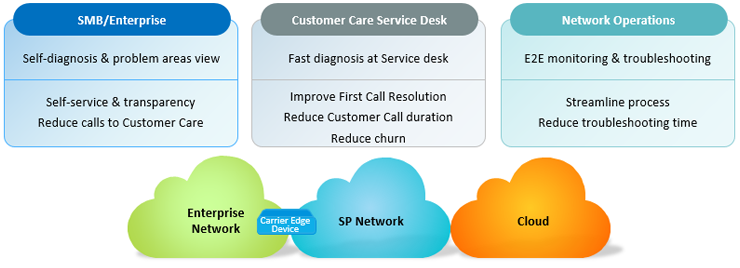
Your Network's Edge®
Blog Post
You are here
How CSPs Can Use Smart Diagnostics to Move Up the Value Chain
With growing competition from traditional rivals and hyperscalers, along with steady decline in ARPU (average revenue per user) CSPs (communication service providers) are increasingly looking for ways to deliver higher customer value, differentiate their offering from cost-intensive commodity. The typical way to go about this is by focusing on enhanced customer experience throughout customer journey while reducing internal costs to keep their prices competitive.
Getting it right at the first touchpoint
Customer support is often the first touchpoint between the operator and the customer when there is a problem with the network. It is therefore crucial that CSPs handle this touchpoint as quickly and efficiently as possible, resolving the issue on the first call and keeping customers, who expect a fast and useful response, satisfied. This requires an intuitive tool to diagnose issues end-to-end, across the entire service path and not only in the CSP network segment. The fact that the CSP network behaves well at the time of the call doesn’t help business customers if they experienced service degradation an hour before and don’t know the source of it. Quite the opposite, such a response often leads to responsibility disputes, customer irritation and, finally, churn.
More and more businesses are moving their enterprise applications to the cloud, increasing their need for a reliable network connectivity service, which today translates to Carrier Ethernet. It has its own built-in mechanisms to ensure the highest connectivity standards, and traditional monitoring and troubleshooting tools used by CSP operations and engineering are designed to support these standards. However, CSPs have much less visibility when it comes to the cloud connectivity segments and enterprise networks, especially if they don’t manage them, as is often the case. Moreover, service desk personnel answering customer calls aren’t highly technical and their work procedures are strict and unambiguous. Therefore, when frustrated customers call the CSP service desk with connectivity issues the ONLY diagnostics the service desk representative can apply is an automated snapshot network health test. In most cases, the customer would then request more insightful information, which requires the escalation of the problem to the next support level – operations.
Escalating customer frustration
To visualize customer experience, find the explanation and provide solution or recommendations, operations would need to check and correlate multiple tools (probe xDRs, alarms, performance counters, network element logs, configurations, existing tickets and recently implemented CRs, etc.). In some cases, they would be forced to involve field teams from operations, engineering, and even vendors. Due to the fragmented view of the service connectivity segments and operational resource constrains, too many customer cases take long time to resolve and even then, a typical answer in the majority of cases would be “no problem found in the CSP network”. Needless to say, such answers don’t contribute much to customers’ satisfaction. They would much rather receive specific, useful answers that definitively direct them to where the problem does lie – their own network, connectivity parameters or their cloud providers.
In fact, CSPs waste considerable resources on customer ticket escalation by attempting to troubleshoot problems unrelated to their network. According to survey among 100 communications service providers, in 76% of business connectivity problems reported to CSP service desks, the source of the problem lies outside the CSP’s scope of control. That’s more than 3/4 of customer cases! Were the service desk staff in a position to provide insightful recommendations, or if such recommendations and insights were available to the customer via a self-service tool, the entire process of handling customer complaints would have been simplified or even avoided altogether.
There is a better alternative
What if there’s a solution that empowers service desk personnel with intuitive, insightful diagnostic tools for persistent and intermittent customer connectivity issues? A solution that provides on the spot, automatically generated answers – in plain language – with recommendations that direct customers to specific areas for remedy or improvement, or information about an ongoing network malfunction? Such an approach builds trust, improves First Call Resolution, improves customer satisfaction and, at the end of the day, reduces churn.
That is exactly the approach we’ve taken at RAD with RADinsight- Smart Network Performance Diagnostics (SD).
It utilizes data that is already available from RAD’s carrier edge devices installed in the network, together with AI/ML and cloud technology. RADinsight SD uses data from all service path domains, OSS and BSS to provide an end-to-end, customer-centric analysis and business insights.
The thinking behind it is focused on providing CSPs with tools to effectively offer their business customers real value beyond simple connectivity, by using their existing resources to solve a major pain point. Other stakeholders and customers can benefit as well, as described in the diagram below:

More details on RADinsight, are available here.

